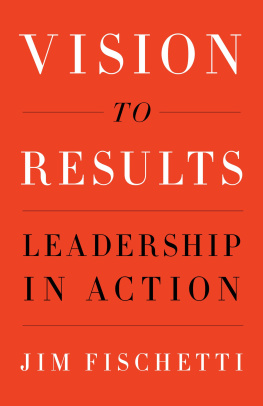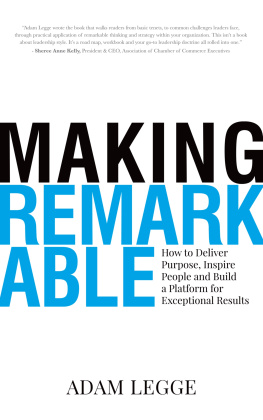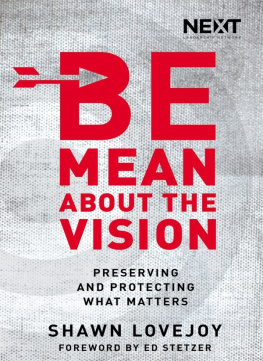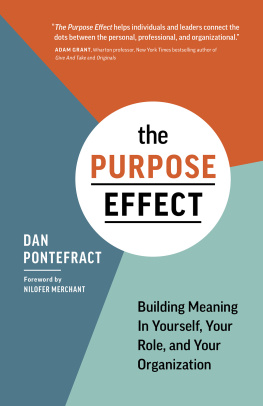All rights reserved.
First, I dedicate this book to Jillmy best friend, partner, and mother of our children. Without her, I never would have achieved the success I have in life or business. Thank you!
Second, to my children Katie and Tommy, son - in - law Adrian, grandson Alastair, and granddaughters Fiona and Catherine. They are why I work as hard as I do.
Third, this book is dedicated to you, the reader. Those who strive to make a difference as a leader are truly the difference makers.
Acknowledgments
This book would not be complete without Ted Flanagan. The hours and hours we spent to create this were so rewarding. Thank you for your hard work and dedication to the process.
There are several people Id like to thank for their investment in me. Without their wisdom, support, mentorship, and love, Id not be the man or leader I am today:
Earl Fincher, an incredible leader, and an even better man.
Brenda Benson, you saw something in me and have always been a coach and cheerleader for me.
Mo Anderson, a true icon of business, you poured into me when you didnt have to. Ive learned so much from you.
Gary Keller, being in your mastermind group transformed my mind and perspective.
Mark Cress, thank you for first putting the idea of a book into my head.
Mike McCarthy, you gave me the opportunity of a lifetime and the freedom to execute, while also challenging me to think bigger and deeper.
Sam Chalfont, the first person outside my family who knew I was going to succeed. His belief changed my life.
Michelle McBride, thank you for pushing me into speaking and teaching.
Paula Hoeft, thanks for showing me how to blend leadership and humility.
Jay Crow, a true gentleman and leader, your wisdom over the years has been invaluable.
Anthony Braswell, a great leader and pastor, who has been an example of love and kindness as he leads.
Bill Garrett, who left this world too young but filled his years with investing in people.
To the hundreds of authors who have poured into me through their books.
To my father - in - law , even though youre gone now, your words and wisdom still live on in my heart and mind.
To my dad, you were my first and last hero.
Introduction
The biggest vision in the room always wins. This might not be a new idea, but its one that too many leaders forget. When leaders forget about the importance of vision, they are not the only ones who sufferso does each member of the organization they lead.
In his book The Innovation Secrets of Steve Jobs , author Carmine Gallo examines vision as the core principle underlying the most fundamental societal change since Gutenberg. Gallo relates the story of a young software programmer named Rob Campbell. Nearly three decades before disruption became a buzzword, Campbell began to grow increasingly fascinated by the possibilities of personal computing. Campbell could sense in this emerging field a world - changing technology, and he wanted in.
At the time, there were only three players in the PC market: Tandy, Commodore, and Apple. Only one of these companies had a leader whose vision allowed them to understand that they were standing on the front lines of a revolution; the other two knew only that there was a little bit of money to be made.
Campbell went on a quest to claim his own place in the PC revolution. First, he interviewed with Tandy, the first giant in the world of personal computing. During the interview, Campbell asked a simple question: What is your vision for the personal computer? The response was less than inspiring. We think it can be a huge hit in the upcoming holiday season, they told him.
Unsatisfied, Campbell next interviewed with Commodore. At the time, Gallo notes, Commodores stock price hovered around $1 per share. Their response to Campbells vision question? We think the PC can help us get our stock price over $2 per share.
Utterly deflated by the myopia of these industry leaders, Campbell scheduled a lunch interview with Jobs, then in his first stint as CEO at Apple. Although Gallo doesnt say, its not hard to imagine Campbell approaching this meeting with a certain amount of fatalism. Although Tandy and Commodore executives had each expressed to Campbell some sort of vision for their companies, he didnt feel compelled to join either. He didnt connect with their vision for their companies. The scope of what these companies wanted, and what they thought the PC could achieve, was far smaller than what the young and ambitious Campbell himself had for the technology. None of us would blame him for approaching the Jobs interview prepared for yet another disappointment. This was, after all, before Steve Jobs was Steve Jobs . At the time, Campbell likely thought of him as just another tech CEO with similarly shortsighted aims for the PC.
Of course, with the benefit of hindsight, we know that Steve Jobs was anything but just another tech CEO with limited vision and insight. Campbell learned this early on in the time he spent with Jobs on that day in 1977.
Campbell broke out his usual question early in their interview. What is your vision for the personal computer? he asked once again. This time, instead of a glib reply about holiday sales or vague promises for a boost in stock prices, Campbells query was met with an impassioned response about the way the PC was going to change the way we work, how we actually did work, how we interact with each other, and how we educate our children and entertain ourselves. It took Jobs an hour to answer Campbells question. Jobs explained his vision for the PC as one of the biggest advances in humanity since the development of Gutenbergs printing press.
Forty years later, Id say Jobs was pretty spot - on , and not just about the future of the PC. What Campbells experience reveals is the way a leaders vision can be both limiting and liberating. The fact that Tandy and Commodore are no longer with us suggests that its not enough simply to hold a vision for your organization. True leadership involves creating a vision, communicating it with evangelistic fervor, and holding people accountable.
Simple enough, right? So why does it seem so rare in practice?
The Tesla Conundrum and the Uber Fix
Even products that ought to do well in a red - hot market might not perform well in the presence of shaky leadership. Consider Tesla, the electric automobile manufacturer. Consumers love Tesla. The demand for their products couldnt be higher. Theres a waiting list to buy a car for crying out loud, and yet the company continues to struggle financially.
It has endured slowdowns in production. Layoffs. Staff turnover. Missed goals, particularly production numbers on their incredibly anticipated Tesla Model 3. At the moment, its very future seems less than assured.
Why?
The reality is that Elon Musk seems unhinged right now. Hes all over the place. His Board of Directors basically had to order him to stop using Twitter. Being a visionary doesnt automatically make you a leader.
Musk is a great example of a brilliant guy whos not cutting it as a leader. Hes performed poorly on investor calls and tried to intimidate people who had legitimate questions about the way Tesla is run. Ultimately, the biggest problem Tesla faces is a lack of clear expectations from the top. People dont know what Tesla is trying to accomplish. Want proof? I bet you cant answer this simple question: Are they a battery company or a car company right now?








